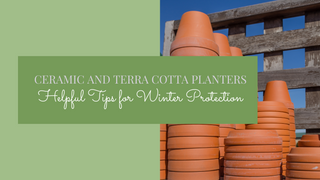As winter approaches, it's time to think about safeguarding your beloved ceramic and terra cotta planters from the harsh effects of freezing temperatures. These beautiful containers can enhance the aesthetics of your garden but they are susceptible to damage if not stored properly during the winter months. In this blog post, we'll explore the potential risks associated with leaving these planters exposed to winter weather, particularly the role of moisture in soil and how it can lead to cracks.
Understanding the Science:
One of the primary dangers for ceramic and terra cotta planters during winter is the expansion of frozen moisture in the soil. When water in the soil freezes, it undergoes a physical change – it expands. The expansion of freezing water can exert significant pressure on the walls of planters, leading to cracks and ultimately compromising the structural integrity of the container.
Storing Dry and Empty:
The most effective way to prevent winter damage to your ceramic and terra cotta planters is to store them dry and empty. Before the first frost sets in, remove any remaining soil from the planters and let them dry thoroughly. This step is crucial because even a small amount of moisture left in the soil can cause trouble when temperatures drop.
Storing the planters empty ensures that there is no water to freeze and expand, minimizing the risk of cracks. Additionally, empty planters are lighter and easier to move, making the storage process more convenient.
Ensuring Soil is Dry:
If emptying the planters completely is not practical, make sure the soil is dry before storing them for the winter. Waterlogged soil can retain moisture, and when this trapped water freezes, it can lead to the same expansion-related issues as with wet soil.
To ensure the soil is dry, stop watering your plants well before the expected first frost. Allow the soil to dry out naturally, and if needed, you can even remove the top layer to speed up the process. Once the soil is dry, you can confidently store your planters without worrying about the damaging effects of frozen moisture.
Covering for Extra Protection:
In addition to ensuring your planters are dry and empty, consider covering them for extra protection. A simple burlap or frost cloth cover can shield your planters from winter precipitation and temperature fluctuations, reducing the risk of moisture getting into the soil. This added layer can be especially beneficial in our region, with unpredictable winter weather.
Caring for your ceramic and terra cotta planters during the winter is essential to preserve their beauty and functionality. By understanding the science behind how moisture in soil can freeze, expand, and cause cracks, you can take proactive steps to ensure the longevity of your beloved ceramic and terra cotta planters.
Whether you choose to store them dry and empty or ensure the soil is dry and cover them for extra protection, these measures will go a long way in safeguarding your planters from the winter chill.


